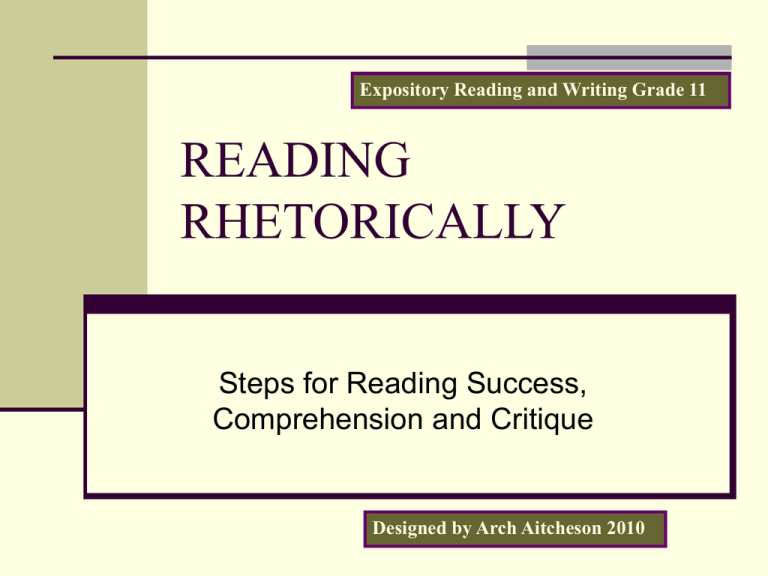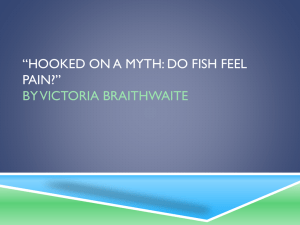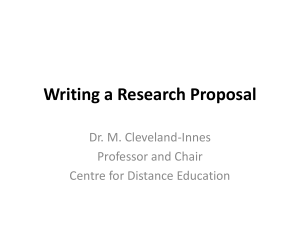Reading - Cloudfront.net
advertisement

Expository Reading and Writing Grade 11 READING RHETORICALLY Steps for Reading Success, Comprehension and Critique Designed by Arch Aitcheson 2010 Three Steps of Rhetorical Reading PREREADING: Getting ready to read the text; Surveying the text; Making predictions and Asking Questions; Recognizing key vocabulary READING: 1st reading; Looking closely at the language; Rereading the text; Analyzing stylistic choices of the writer; Evaluating the structure of the text POSTREADING: Summarizing the text and responding; Thinking Critically Pre-reading: Getting Ready! Do a quick-write about the topic (5 minutes). How does the topic connect with the student’s personal world and the world of the text? What prior knowledge and experience related to the topic and its issues does the student have? What do you think the text will be about? Write answers to these questions in your journal! (CA Standard Writing 2.3) Pre-reading: Surveying the Text Survey the text! Look at the title and at subtitles. What do they tell you about the content or position of the text? Look at the length of the reading. Find out what you can about the author from library or internet research. Does the text offer information? When and where was this text published? Highlight or make a lit log of topics and main ideas that seem to be presented. ( CA Standard: Reading 2.1) Pre-Reading Braithwaite Text—“Hooked on a Myth: Do Fish Feel Pain?” The following questions, applied to the Rifkin article, are equally relevant here: Where and when was this article published? Who wrote the article? Do you know anything about this writer? (Hint: Look at the END of the article.) How could you find out more? Is this writer more or less credible than Jeremy Rifkin? Why or why not? Pre-Reading: Making Predictions What do you think the text will be about? What do you think is the purpose of the text? Who do you think is the intended audience? How do you know? What clues are given? Based upon the title and other features, what information or ideas might the text present? CA Standard: Reading Comprehension 2.1 Making Predictions (Braithwaite) What is title of the article? The subtitle? What do these words tell you about what the article might say? Can you make some predictions? Pre-Reading: Asking Questions What is the topic of the text? What is the author’s opinion about the topic based on pre-reading information? What does the reader think that the writer wants him/her to believe? How does the reader know? How can the title of the text be turned into a question or questions to be answered as the student reads the text? CA Standard: Reading Comprehension 2.3 Asking Questions (Braithwaite) Before reading the Braithwaite article, discuss the following questions: 1. Have you ever gone fishing? Did you catch a fish? What did the fish do? How did it behave? Did you eat it? 2. What other experiences have you had with live fish? Do you have an aquarium at home? Have you been to a public aquarium? What did you learn from these experiences? 3. From your experiences, do you think that fish feel pain? Why or why not? Pre-Reading: Vocabulary Identification Scan the text and write down key words that seem to be important to the topic. What do the words mean? Write the words down with definitions from dictionaries and by using word parts (prefixes, suffixes, infixes and core word parts) Develop a vocabulary log for the particular text. CA Standards: Systematic Vocabulary Development 1.0; 1.1; 1.2 Understanding Key Vocabulary (Braithwaite) Look at this list before reading the article. Because the article is written for non-scientists, it defines many of these words in the text. 1.nociceptors (¶ 3): nerve endings that detect damage and cause feelings of pain 2.trigeminal nerve (¶ 3): the main nerve for the face in all vertebrates 3.vertebrates (¶ 3): animals with a spine 4.A-delta and C fibers (¶ 3): types of nociceptors 5.noxious (¶ 5): harmful, poisonous or unpleasant 6.adverse behavior (¶ 5): contrary, harmful or unfavorable 7.mammalian (¶ 12): an adjective describing animals that have breasts and nurse their young 8.amygdala (¶ 12): part of the brain associated with emotions 9.hippocampus (¶ 12): part of the brain associated with memories 10.automata (¶ 13): a self-operating machine 11.crustacean (¶ 17): an animal with an exoskeleton such as a crab, shrimp, or lobster Reading: First Reading! Reading with the grain and testing for truth Read the text through; which of the predictions turned out to be true? Write them down! Use SQP2RS reading strategies. (Survey, Question, Predict, Read, Recall, Review) What in the text surprised the student reader? Write the surprises down. Make a rhetorical triangle for the piece using prereading information and what was discovered in the first reading. CA Standards: Reading Comprehension 2:1 Reading: First Reading . . . Cont. Annotate the text looking for literary and rhetorical devices used by the writer. Add book tags that identify areas that need clarification or cause trouble for you. Ask the questions designed in pre-reading based upon the title or main topic as you read. Can you find answers? Take small chunks of the text and create a descriptive outline. CA Standards: Reading Comprehension 2.2 Reading: First Reading & Vocabulary Using the Vocabulary list from Pre-reading: Do the definitions clarify what the author is saying? How does the vocabulary help the reader understand the writer’s perspective, purpose and main idea? Are there new words that need defining to make the text understandable? Write these down and look up their meanings! CA Standards: Word Analysis, Fluency… 1.0 Answer the following questions about the Braithwaite text: 1. What is the effect of the use of scientific terms in an article that is written for newspaper readers? 2. Do these terms confuse the reader? 3. Do they make the writer more credible? 4. Do they help the reader understand the type of argument being made? Reading: Rereading the Text 1 Reading “against the grain” seeking the truth. Add commentary to the previous annotations as you reread the text a second time. What surprised you? With what points do you disagree? Agree? What has confused you? What questions do you have? What have you learned that you did not know? How have you changed your perception of the topic or issue? CA Standard: Research and Technology 1.7 Against the Grain (Braithwaite) Question the text in your second reading, “reading against the grain” and “playing the disbelieving (or doubting) game.” As you read, look for claims and assertions Braithwaite makes. Does she back them up? Do you agree with them? Reading: Rereading the Text 2 Label or write down the following items for the text: The Introduction: Background and Invitation The predominant issue addressed by the writer The main arguments the writer uses to support his/her invitation The examples or analogies made by the writer to illustrate his/her stance The conclusion CA Standard: Reading Comprehension 2.2 Rereading Braithwaite As you read, do the following: Underline (with a double underline) or highlight in one color the thesis and major claims or assertions made in the article. Underline (with a single underline) or highlight in a second color the evidence in support of the claims and assertions. Write your comments and questions in the margins After reading the article again, answer the following questions: What is the thesis of Braithwaite’s article? Does Braithwaite make any claims that you disagree with? What are they? Do any claims lack support? Reading: Analyzing Stylistic Choices 1 Diction (Word Choices) What are the denotative and connotative meanings of the key words in the text? How do these meanings affect the reader’s response? What words or synonyms are repeated? Why? What figurative language does the writer use? What does the type of figurative language used imply? (Tone, mood, irony, “sound” of language, etc.) CA Standard: Literary Response and Analysis 3.3 Reading: Analyzing Stylistic Choices 2 Syntax (Sentence Structure) Has the writer provided a variety of types of sentences? Which types can you identify? What effects do choices of syntax and length have upon the reader? CA Standard: Literary Response and Analysis 3.3 Reading: Structure of the Text 1 Mapping the text’s organizational structure Draw a line where the introduction ends – 1st paragraph or several? Highlight or underline the invitation (thesis) Divide the rest of the text into thematic or structural sections. Draw a line where the conclusion begins. CA Standard: Reading Comprehension 2.1;2.2 Reading: Structure of the Text 2 Rhetorical Triangle Revisit the triangle you have started previously and fill out the rest of the areas –especially the context and tools box! Revise your understanding of the writer’s purpose as needed! CA Standard: Reading Comprehension 2.2 Reading: Structure of the Text 3 Descriptive Outlining: How does each section affect the reader? What is the author trying to accomplish? What is the content of each section? Which section is most developed? Which section is least developed? Does it need more development? Which section is most persuasive? Least persuasive? What do you think is the author’s main argument? Is it clearly stated or implied? CA Standard: Reading Comprehension 2.1; 2.1 Descriptive Outline (Braithwaite) Do a descriptive outline of the Braithwaite text. Are we justified in treating fish differently from other animals? Post Reading: Writing a Summary and Thinking Critically Using the previous steps write a paragraph that accurately and critically summarizes the text. Write 4 or 5 questions that might be used for a class discussion or seminar based upon the text. Use the Thinking Critically approaches we have learned earlier this year to help design those questions! CA Standard: Writing Application 2.5 Summarizing and Responding— Quickwrite Summarize the article in your own words, answering the following questions: Why does Victoria Braithwaite think that we should treat fish more like the way we treat other animals, such as birds and mammals? Do you agree? Why or why not? Results? If you have followed these steps, you will have the material and information needed to provide a clear expository and critical essay response to the reading. The process may seem cumbersome but with practice, can be a natural method to read for comprehension and to write with authority and confidence! We shall be practicing these methods for the balance of the school year! Print out a copy of the slide thumbprints for your binder! It will provide an excellent guide!




